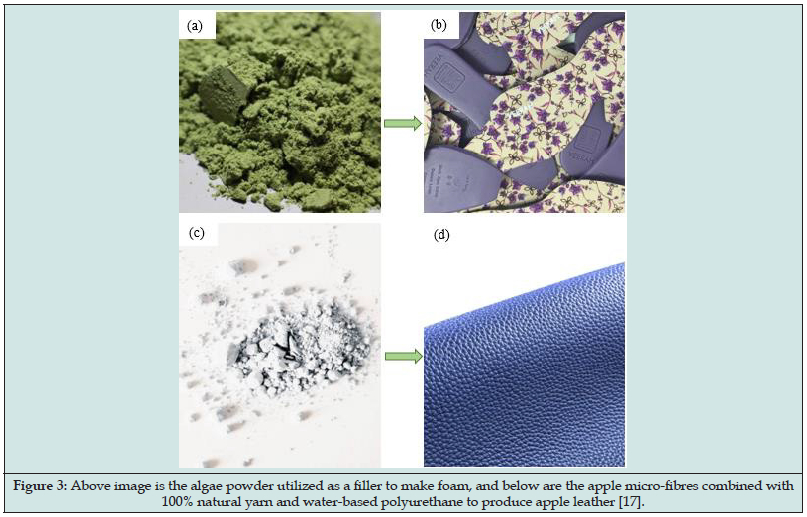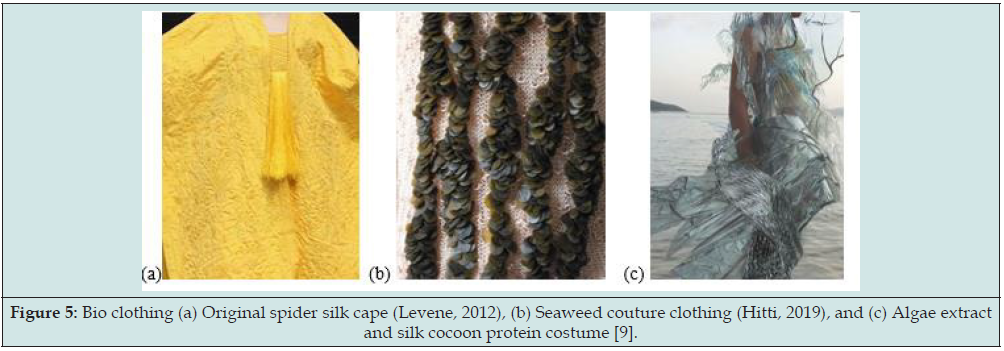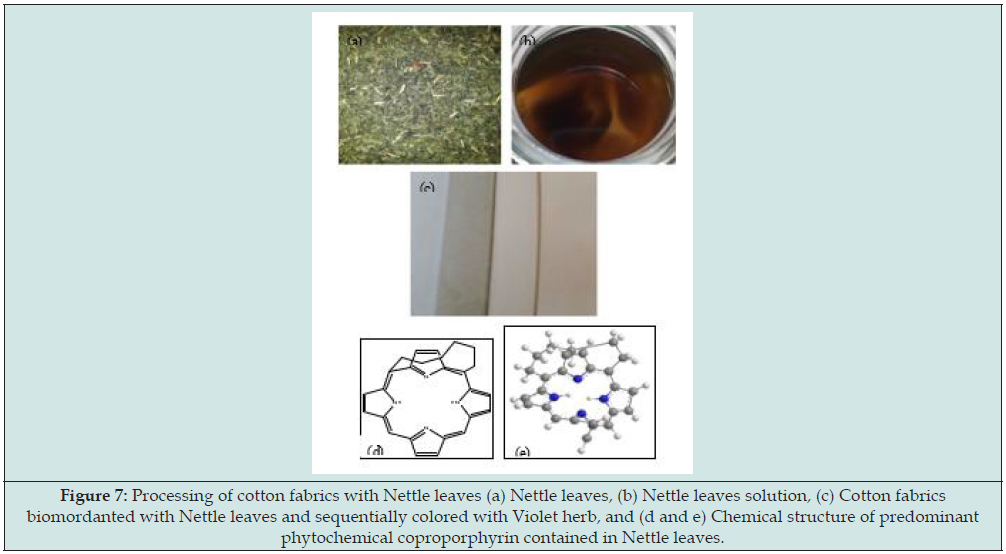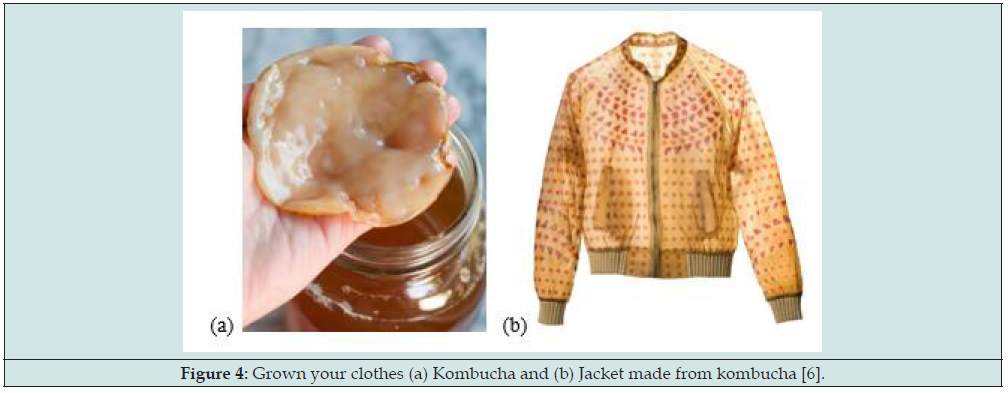
Lupine Publishers Group
Lupine Publishers
Menu
ISSN: 2637-4595
Review Article(ISSN: 2637-4595) 
A Perspective on Biomimicry for Textiles Volume 5 - Issue 2
Alka Madhukar Thakker* and Danmei Sun
- School of Textiles and Design, Heriot Watt University, UK
Received:September 12, 2022 Published: November 17, 2022
*Corresponding author: Alka Madhukar Thakker, Email address: roseswaterlilies@gmail.com
DOI: 10.32474/LTTFD.2022.05.000209
Abstract
In this article, a point of view is presented on biomimicry for textiles highlighting the laws of nature and sustainability. The papers cite significant examples of inspiration from nature applied for synthesizing novel textile materials such as shape-grow mycelium and bacterial cellulose besides pineapple and apple leathers. The parallel ideas created from sharks’ skin, stomata on plants’ surfaces and pinecone structure to develop thermoregulatory wear are discussed in this paper. Generating spider-silk fibres and fibres from food waste, distilling colours from surplus flowers and structural colours from nature applying the principles of physics and quantum are presented with critical analysis. It is attempted to clarify that bioinspiration would not be sustainable if mingles with water and energy-demanding processing. Meanwhile, a belief in biomimicry in the true sense or simply the analogue application is presented. Moreover, the conviction that biomimicry synonym eco-friendly is obscure, hence the mini perspective makes efforts to refine it. Several natural fibres especially cotton, linen and others are biomimicry the standpoint on the dire need to purify cotton and linen production is voiced in contrast to the constant felt need and hype of exploring or manipulating nature for more as there is no planet B.
Keywords: Biomimicry, Sustainable Textiles, Nature-Inspired Textiles, Natural materials, Eco-Friendly Fashion
Introduction
Nature is full of inspiration. The viewpoint is that the laws of nature are equivalent to basic manuals for living life on the planet that will put the whole universe into a mode of sustainability by default.
Listed below are the twelve laws of nature [1].
a) The law of oneness (Source is one)
b) The law of vibration (Energy levels)
c) The law of action (Karma)
d) The law of correspondence (What is inside gets reflected outside)
e) The law of cause and effect (Action-reaction to get balance)
f) The law of attraction (Connection)
g) The law of compensation (You reap what you sow to get equilibrium)
h) The law of perpetual transmutation (Change is constant)
i) The law of relativity (Good is valued due to the bad)
j) The law of polarity (Yin & Yang)
k) The law of rhythm (Patterns & Cyclic nature)
l) The law of gender (Prakriti and Purusha)
In this way nature is our role model; we are co-workers who ought to adapt to and harmonize within the system of nature and not vice versa. It is oblivious that going contrarywise has thrown the entire framework out of balance leading to the climate crisis, diseases, and others as summed up in the 17 Sustainable Development Goals that must be addressed. With textiles and fashion being no exception, the system of nature applies to it, in fact in the first place as it is the second largest polluter in the world. The standpoint is to awaken and get conscientious about it.
Bio design for textiles and fashion
Diverse mindsets are working towards propelling sustainability in textiles such as C. Collet, a bio designer who engages in growing mycelium with different patterns that could replace petroleumbased binding agents and tie-dye materials and processing an example of which is shown in (Figure 1). In the same vein, bacterial cellulose is cultivated and widely researched for application in the textile, medicine, food, and paper industries [2]. The processing is performed at ambient temperature and materials are biodegradable.
Sharkskin scales and denticles were studied resulting in exclusive swimwear that changes shape as per the swimmer’s body during swimming and reduces the water drag. The minuscule apertures called stomata on the plant leaves take in carbon dioxide and give out oxygen including water vapour. Similarly, the pinecone plant structure remains closed and protects the seeds until external optimum temperature and humidity are reached. This phenomenon was implemented for structuring climate-adapting textiles capable of maintaining a balanced microclimate applicable for sportswear and compression garments [2]. There is an analogous application of biomimicry. The materials and methods are unsustainable amounting to emissions and effluents; hence biomimicry is not synonymous with being eco-friendly. The principle of Green Chemistry needs to be adopted to meet up to SDGs for climate action, life below water and life on land.
Additionally, employing waste generated from agricultural and food production can effectively generate ecological fibres and fabrics. For instance, the fabric is made from orange and citrus fruit peels by an innovative patented method. Even more a cellulosic fabric is further constituted by blending orange and lyocell fibres [3]. The pictorial depiction is given in (Figure 2), showing a nature-based solution for sustainability in textiles and fashion. Synchronously, plant-based leathers are manufactured from cereal crops, pineapple, cactus, corn, apple peels, and flowers by a carbonneutral process to save animals [7]. An example is given in (Figure 3). An algae is utilized for making foam [16], which is a partially ecofriendly nature-based solution for eco-friendly textiles and fashion. Surprisingly, spider silk was found to be stronger than steel hence a team of scientists at the University of Cambridge produced artificial spider silk with super molecular polymer-colloidal hydrogel at room temperature [3]. Moreover, geckos’ feet were found to be super adhesive to flat surfaces inspiring the production of bioadhesives with superior efficiency as compared to contemporary sticky adhesives. Likewise, the superhydrophobic and therefore self-cleaning fabrics were made from inspiration from lotus plant stems and leaves [3]. Several species in nature such as feathers of aquatic animals namely duck (For hydrophobicity), Morpho butterfly wings metallic blue colour (For structural colours), illuminating fireflies (For structural irradiance), and multi-radiant peacock feathers (For structural luminescence) have been creatively explored for application in textiles and fashion for varied purposes. The structural exhibition of colours involves optical light scattering, diffraction, multi-layer, and angle dependencies resulting in the observed colour [2].
Figure 3: Above image is the algae powder utilized as a filler to make foam, and below are the apple micro-fibres combined with 100% natural yarn and water-based polyurethane to produce apple leather [17].

Nature inspired clothing
The five elements of nature namely earth, water, air, fire, space, also flora and fauna have inspired fashion designers ever since. The images, patterns, colours, textures, and proportions as in nature are adapted for clothing. The materials, methods, and phenomena in the sky such as lightning, rain, sun, moon, stars, and several others have constantly fed the designers’ minds with creativity. Likewise, the miracles of the sea world have equally caught attention for designing fabrics and garments such as jellyfish, horseshoes, starfish, sharks, dolphins’ etcetera. Primarily biomimicry clothing has iconographic and emotionally stimulating designs [4]. (Figure 4a) as explained by Suzanne Lee is the scoby clothing that could be made from kombucha. She promulgated on growing your clothes as noted in her TED talk [5]. A jacket made from kombucha is shown in (Figure 4b). The scoby clothing is biodegradable [6].
(Figure 5a) displays a cape made from 1.2 million golden orb spider silk. The cape was made by Simon Peers and Nicholas Godley in Madagascar. The hand-woven cape is naturally golden in colour and it took 8 years to create the cape [7]. (Figure 5b) is an example of seaweed couture clothing presented by textile designer Jasmine Linington. The seaweed, wood and lyocell fibres materials were combined to create the varied garments and bio-iridescent sequins. A sustainable alternative to invasive materials was suggested [8]. (Figure 5c) depicts a costume created by Scarlett Yang utilizing algae extract and silk cacoon protein [9]. (Figure 6) displays nature-inspired clothing designed by Iris van Herpen. The collection was named Meta Morphism [10]. Together, the need is to contain the sustainability perspective. Nature is the strongest. We ought to respect our mother nature so that she can sustain us with her abundant benevolence.
Figure 5: Bio clothing (a) Original spider silk cape (Levene, 2012), (b) Seaweed couture clothing (Hitti, 2019), and (c) Algae extract and silk cocoon protein costume [9].

Figure 6: Nature-inspired clothing named Meta Morphism (a) Alike to aquatic fauna and (b) Alike to butterfly [10].

Natural fibres and colours
Concurrently, the ancient examples of biomimicry in textiles such as cotton, linen, bamboo, and other processing ought to be cleaned for which it is essential to formulate strategies that would allow manufacturing at lower ratios of materials, water, and energy demands. For instance, currently, cotton production generates 3,644 cubic meters per tonne of carbon footprints from its water consumption alone [11]. Besides, 6.2% of the global pesticide sale is accounted for cotton, and 60% of the world’s cotton is sourced from small-scale farmers who are the poorest sector in the world. Additionally, it involves forced child labour, soil depletion, increasing land consumption due to the growing population and volatile cotton market conditions [11]. All these indicators are more than sufficient to obscure the purpose of biomimicry. In the same vein, dyeing and printing with natural colours are promulgated for sustainability reasons and serve as an excellent example of biomimicry. Therefore, it is noteworthy to mention that cotton was colored with hops flowers and violet herbs with plant-based metal mordants from bilberry leaves, nettle leaves, dandelion leaves, and black cherry stem an example of processing of cotton fabrics with nettle leaves and the violet herb is illustrated in (Figures 7a-7d). The process of natural dyeing was accomplished by implementing low material to liquor ratio of 1:10, processing at ambient temperature and below 60℃ to protect functional phytochemicals and original colour production and replacing synthetic mordants with plant-based mordants for improved colour fastness properties [12]. Moreover, herbal inks developed from bio indigo, quebracho red and the flame of the forest plants for digital printing of wool and cotton fabrics gave low emissions and effluents [13]. The inspirations from nature are limitless [14-18].
Figure 7: Processing of cotton fabrics with Nettle leaves (a) Nettle leaves, (b) Nettle leaves solution, (c) Cotton fabrics biomordanted with Nettle leaves and sequentially colored with Violet herb, and (d and e) Chemical structure of predominant phytochemical coproporphyrin contained in Nettle leaves.

Conclusions
It is apparent that we are within nature that inspires us immensely for creating exotic eco-friendly textiles for fashion and textiles. Based on the viewpoints illustrated the following conclusions could be made.
a) The Laws of nature are basic to sustainability in any field including the textiles and fashion sector.
b) Biomimicry implies inspiration from nature, and it might not be eco-friendly for example swimwear inspired by shark fish skin or artificial spider silk and others.
c) Nature-inspired bio design could be completely ecological for example spider silk cape or garment made from algae and silk cocoon protein and others.
d) The bio-inspired product could be partially sustainable such as algal foam or leathers from fruit peels and others.
e) It is essential to channelise massive efforts in making the existing nature-based materials and processing sustainable like cotton, linen, bamboo, and others.
f) The existing range of petroleum-based colours and fibres could be rendered ecological by devising strategies such as structural modifications, manufacturing and processing at lower temperatures and solvent demands and others.
g) The colouration with natural materials could be processed in an eco-friendly way by eliminating metallic mordants and replacing them with plant-based metal mordants for example copper and ferrous mordants from black cherry stems, dandelion leaves, violet herb, and others.
h) Best from waste such as colours from waste flowers, fruits, food and agricultural waste and others are biomimicry too.
i) Biomimicry combined with principles of Green Chemistry would propel sustainability in a big way.
Acknowledgement
The authors are grateful the Heriot-Watt University.
Statement of Disclosure
There are no conflicts whatsoever.
Ethical Approval: No animals or human beings are involved in the study experiments.
Consent to Participate: Authors consent to Participate.
Consent to Publish: Authors consent to Publish.
Authors Contributions: Author DS as Supervisor & AMT as experimenter and writer.
Funding: No Funding to Proclaim.
Competing Interests: No Competing Interests.
Availability of data and materials: Authors consent to the availability of data and materials with appropriate citations being provided.
References
- Oldale R J (2019) The 12 Universal Laws of Nature.
- Wood J (2019) Bioinspiration in Fashion-A Review. Biomimetics 4(1): (16).
- Orange Fiber Srl (2022) The First Fabric from Oranges.
- Anzabi N (2016) Nature Inspired Clothing Design Based on Biomimicry. INTAN management journal 1: 241-251.
- Suzanne Lee, TED Conferences LLC (2022) Grow your clothes.
- Knutson A (2019) Did You Know You Can Make Clothes out of Your Kombucha Scoby?
- Levene D (2012) Golden cape made with silk from a million spiders - in pictures.
- Hitti N (2019) Jasmine Linington uses seaweed to make couture clothing.
- design (2022) Dezeen (@dezeen) on Instagram: Central Saint Martin’s graduate @scarlettyang_ used algae extract and silk cocoon protein to create.
- Herpen I v (n.d) Meta Morphism.
- Cotton UP (2018) Why source sustainable cotton?
- Thakker Alka, Sun Danmei (2022) Innovative Plant-Based Mordants and Colorants for Application on Cotton Fabric. The Journal of Natural Fibres.
- Thakker A, Sun D, Bucknall D (2022) Inkjet printing of plasma surface-modified wool and cotton fabrics with plant-based inks. Environmental Science and Pollution Research 29: 68357-68375.
- Davies, N. (2019). Biomimicry and Textiles: Inspiration from Nature.
- Dumanlia AG, Thierry S (2016) Recent advances in the biomimicry of structural colours. RSC, Chemical Society Reviews 45: 6698-6724.
- Hirsh S (2020) These Companies Are Making Vegan Leather Out of Plants Instead of Plastic.
- Veerah (2022) Apple leather.
- Williams N, Collet C (2020) Bio design and the Allure of “Grow-made” Textiles: An Interview with Carole Collet. GeoHumanities 7(1): 345-357.

Top Editors
-

Mark E Smith
Bio chemistry
University of Texas Medical Branch, USA -

Lawrence A Presley
Department of Criminal Justice
Liberty University, USA -

Thomas W Miller
Department of Psychiatry
University of Kentucky, USA -

Gjumrakch Aliev
Department of Medicine
Gally International Biomedical Research & Consulting LLC, USA -

Christopher Bryant
Department of Urbanisation and Agricultural
Montreal university, USA -

Robert William Frare
Oral & Maxillofacial Pathology
New York University, USA -

Rudolph Modesto Navari
Gastroenterology and Hepatology
University of Alabama, UK -

Andrew Hague
Department of Medicine
Universities of Bradford, UK -

George Gregory Buttigieg
Maltese College of Obstetrics and Gynaecology, Europe -

Chen-Hsiung Yeh
Oncology
Circulogene Theranostics, England -
.png)
Emilio Bucio-Carrillo
Radiation Chemistry
National University of Mexico, USA -
.jpg)
Casey J Grenier
Analytical Chemistry
Wentworth Institute of Technology, USA -
Hany Atalah
Minimally Invasive Surgery
Mercer University school of Medicine, USA -

Abu-Hussein Muhamad
Pediatric Dentistry
University of Athens , Greece

The annual scholar awards from Lupine Publishers honor a selected number Read More...







